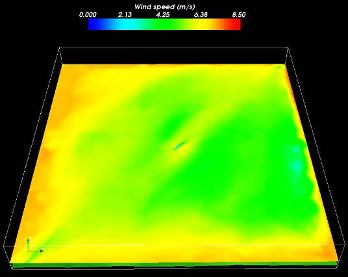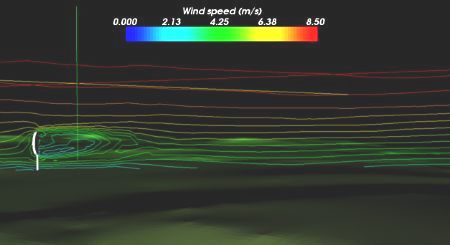 |
|
Research :: wind modelling
Accurate prediction of wind farm performance is of great value to the renewable energy industry, and computer modelling provides an avenue to achieving this goal. Effective numerical simulation of wind turbines and their trailing wakes requires that distances of tens of rotor diameters must be considered, together with sufficient detail of the surrounding physical environment. Free-stream turbulence is also important, as is that generated by the turbines themselves - and yet any proposed model must be computationally simple enough to make it possible to factor all these with modest computing resources. Recent work with the Heriot-Watt turbine model has seen it validated against an actual turbine at a test site, in joint project with a renewable energy consultancy. Simulation wake profile data was compared with on-site measured wake profile data taken from LIDAR equipment. The simulation included such features such as land relief and ground features, modelled using Ordinance Survey (OS) map data. As the real turbine was located in complex, hilly terrain, a large domain volume was selected (6km x 6km x 750m) to allow complex flow features to fully develop before air entered the turbine. 
Proposed research will scale up simulations to full wind farms of 50 turbines and more, and in a co-operative effort with renewable energy suppliers, validate this modelling with extensive wake measurements and turbine performance data. This achieved, the next stage will see the development a planning tool for wind farm developers, which using state-of-the-art CFD techniques to give more effective wind resource estimates than current technology provides. | |
 | |
| © Copyright 2010 Heriot-Watt University | Disclaimer | • | Freedom of Information |

